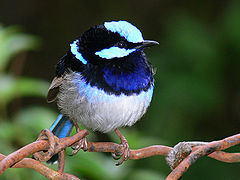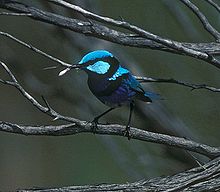- Maluridae
-
Maluridae 
Male Superb Fairywren
(Malurus cyaneus, Maluridae)Scientific classification Kingdom: Animalia Phylum: Chordata Class: Aves Order: Passeriformes Suborder: Passeri Superfamily: Meliphagoidea Family: Maluridae
Swainson, 1831Genera - Malurus
- Sipodotus
- Clytomyias
- Stipiturus
- Amytornis
The Maluridae are a family of small, insectivorous passerine birds endemic to Australia and New Guinea. Commonly known as wrens, they are unrelated to the true wrens of the Northern Hemisphere. The family includes 14 species of fairywren, 3 emu-wrens, and 10 grasswrens.
Contents
Description
Malurids are small to medium birds, inhabiting a wide range of environments, from rainforest to desert, although most species inhabit grassland or scrub. The grasswrens are well camouflaged with black and brown patterns, but other species often have brilliantly coloured plumage, especially in the males.[1]
They are insectivorous, typically foraging in underbrush. They build domed nests in areas of dense vegetation, and it is not unusual for the young to remain in the nest and assist in raising chicks from later clutches.[1]
Fairywrens are notable for several peculiar behavioral characteristics. They are socially monogamous and sexually promiscuous, meaning that although they form pairs between one male and one female, each partner will mate with other individuals and even assist in raising the young from such pairings. Males of several species pluck petals of conspicuous colors and display them to females for reasons unknown.
The song of fairywrens is pleasant and complex, and at least two species (Superb and Splendid) possess, in addition to the alarm calls common to - and universally understood by - most small birds, another vocalization used when confronted by predators. This, termed "Type II Vocalization," is song-like and used when confronted by calling butcherbirds, and sometimes other predatory birds. Its purpose is, however, unknown; it is certainly not a warning call.[2]
Systematics
As with many other Australian creatures, and perhaps more than most, the species making up this family were comprehensively misunderstood by early researchers. They were variously classified as Old World flycatchers, Old World warblers, and Old World babblers. In the late 1960s morphological studies began to suggest that the Australo-Papuan fairywrens, the grasswrens, emu-wrens and two monotypic wren-like genera from New Guinea were related and, following Charles Sibley's pioneering work on egg-white proteins in the mid-1970s, Australian researchers introduced the family name Maluridae in 1975.[3]
With further morphological work and the great strides made in DNA analysis towards the end of the 20th century, their position became clear: the Maluridae are one of the many families to have emerged from the great corvid radiation in Australasia. Their closest relatives are the Meliphagidae (honeyeaters), and the Pardalotidae.[4][5] Their obvious similarity to the wrens of Europe and America is not genetic, but simply the consequence of convergent evolution between more-or-less unrelated species that share the same ecological niche.
Species
(part of the super-family Meliphagoidea)
FAMILY: MALURIDAE
- Subfamily: Malurinae
- Tribe Malurini
- Genus Malurus
- Broad-billed Fairywren, Malurus (Chenorhamphus) grayi
- Lovely Fairywren, Malurus amabilis
- Variegated Fairywren, Malurus lamberti
- Blue-breasted Fairywren, Malurus pulcherrimus
- Red-winged Fairywren, Malurus elegans
- Superb Fairywren, Malurus cyaneus
- Splendid Fairywren, Malurus splendens
- Purple-crowned Fairywren, Malurus coronatus
- Red-backed Fairywren, Malurus melanocephalus
- White-winged Fairywren, Malurus leucopterus
- White-shouldered Fairywren, Malurus alboscapulatus
- Emperor Fairywren, Malurus cyanocephalus
- Genus Sipodotus
- Wallace's Fairywren, Sipodotus wallacii
- Genus: Clytomyias
- Orange-crowned Fairywren, Clytomyias insignis
- Genus Malurus
- Tribe Stipiturini
- Genus Stipiturus
- Southern Emu-wren, Stipiturus malachurus
- Mallee Emu-wren, Stipiturus mallee
- Rufous-crowned Emu-wren, Stipiturus ruficeps
- Genus Stipiturus
- Tribe Malurini
- Subfamily Amytornithinae
- Genus Amytornis
- Grey Grasswren, Amytornis barbatus
- Black Grasswren, Amytornis housei
- White-throated Grasswren, Amytornis woodwardi
- Carpentarian Grasswren, Amytornis dorotheae
- Short-tailed Grasswren, Amytornis merrotsyi
- Striated Grasswren, Amytornis striatus
- Eyrean Grasswren, Amytornis goyderi
- Thick-billed Grasswren, Amytornis textilis
- Dusky Grasswren, Amytornis purnelli
- Kalkadoon Grasswren, Amytornis ballarae
- Genus Amytornis
References
- ^ a b Garnett, Stephen (1991). Forshaw, Joseph. ed. Encyclopaedia of Animals: Birds. London: Merehurst Press. pp. 196. ISBN 1-85391-186-0.
- ^ Greig, Emma I.; Pruett-Jones (2009). "A predator-elicited song in the splendid fairy-wren: warning signal or intraspecific display?". Anim. Behav 78: 45–52. doi:10.1016/j.anbehav.2009.02.030.
- ^ Schodde R (1975). Interim List of Australian Songbirds. Melbourne: RAOU.
- ^ Barker, FK; Barrowclough GF, Groth JG (2002). "A phylogenetic hypothesis for passerine birds; Taxonomic and biogeographic implications of an analysis of nuclear DNA sequence data". Proc. R. Soc. Lond. B 269 (1488): 295–308. doi:10.1098/rspb.2001.1883. PMC 1690884. PMID 11839199. http://www.pubmedcentral.nih.gov/articlerender.fcgi?tool=pmcentrez&artid=1690884.
- ^ Barker, FK; Cibois A, Schikler P, Feinstein J, Cracraft J (2004). "Phylogeny and diversification of the largest avian radiation" (PDF). Proc. Natl. Acad. Sci. USA 101 (30): 11040–11045. doi:10.1073/pnas.0401892101. PMC 503738. PMID 15263073. http://www.tc.umn.edu/~barke042/pdfs/Barker.et.al04.pdf. Retrieved 2007-10-12.
- Josep del Hoyo J.; Elliot, A. & Christie D. (editors). (2007). Handbook of the Birds of the World. Volume 12: Picathartes to Tits and Chickadees. Lynx Edicions. ISBN 9788496553422
External links
- Maluridae videos on the Internet Bird Collection
- Meliphagoidea - Highlighting relationships of Maluridae on Tree Of Life Web Project
Categories:- Maluridae
- Bird families
- Higher-level bird taxa restricted to the Australasia-Pacific region
Wikimedia Foundation. 2010.


